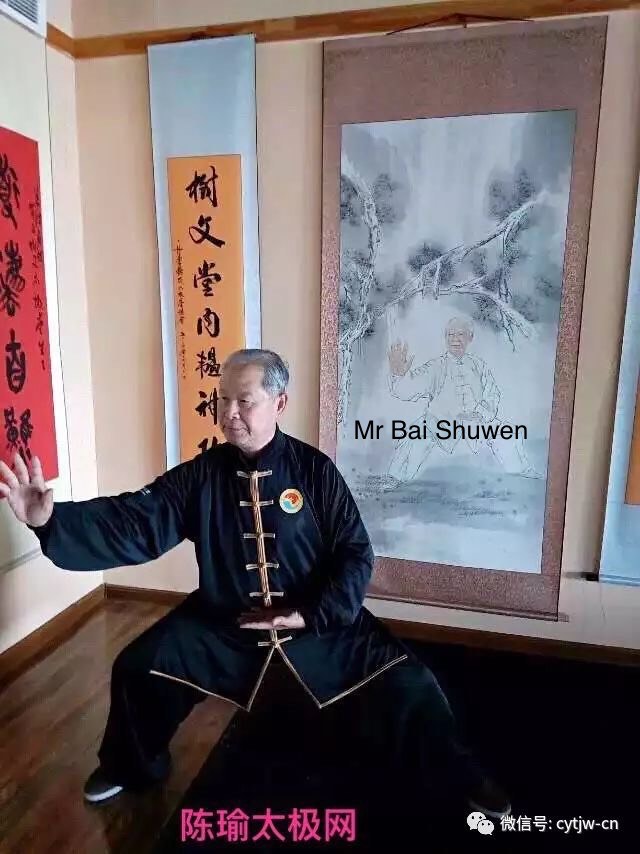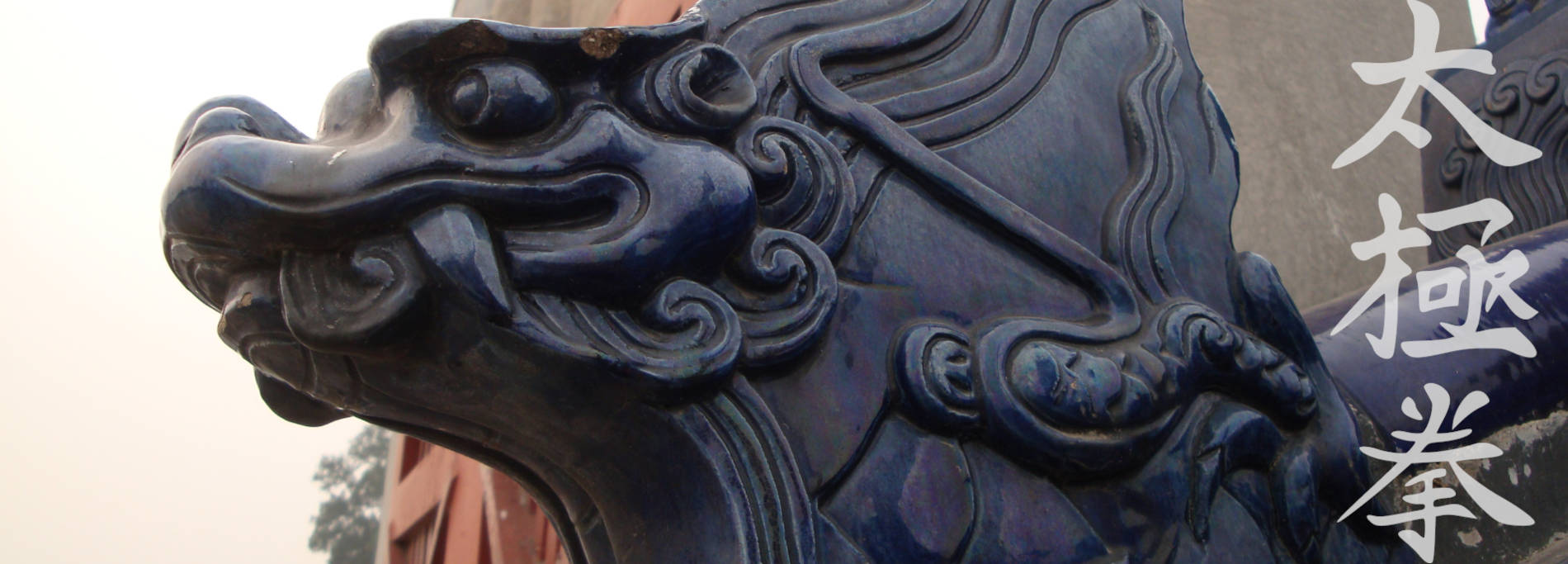Memoirs of learning boxing with Mr. Chen Zhaokui (Episode I)
By Bai Shuwen
In the spring of 1971, I worked in the Political Department of the first artillery. Through the recommendation of Wang Ju of the Logistics Department in the second artillery, I was lucky to meet Mr. Chen Zhaokui in Nan Li Shi park. At that time, he was teaching Yilu 83 Form Chen Taijiquan. This was the first time I saw Chen Taijiquan. In his teaching demonstration, Chen laoshi displayed every movement with a deep level of gongfu. His exquisite quan skills deeply attracted me. Right at that moment, I was secretly determined to learn boxing from Chen laoshi.
At that time, a third of the yilu (first road) form had already been taught, I joined midstream and began to follow suit. After Chen Zhaokui taught boxing, Da Yangzi led us to review again and again. If I didn't understand anything, I asked martial brother Wang Ju to tutor me. Wang Ju learned boxing in the second half of 1970. His quan jia (boxing frame) was relaxed and generous, and his body method correct. He won Chen Zhaokui's true transmission. With his help, I gradually kept up with the progress. I am very grateful to elder martial brother Wang. Without his help, it would have been difficult for me to stick to it.
 In 1989, I invited elder martial brother Wang and younger martial brother Chen Yu to Dan Dong to pass on the art to Chen Taijiquan enthusiasts in the locale, and augment the friendship with the hosts. Chen Yu laoshi teaches the boxing very carefully, meticulously, and his use of language is vivid. You can understand it immediately when you listen to it. For example, when talking about "empty neck and crown of the head force" (xu ling ding jin 虚领顶劲), he said: "if you want someone to pick up the pigtail on your head, you can't bow your head or hold your head in a skewed or slanted position to the left and right." Then, he picked up a shirt, held its collar in his right hand and lifted it up. The garment naturally drooped. He said: “Only when you use your 'crown force to lead up' and your spirit is lifted up, then you can then relax (fang song) your whole body. Like this garment, it is smooth and free from force. This is the first essence of Taijiquan.”
In 1989, I invited elder martial brother Wang and younger martial brother Chen Yu to Dan Dong to pass on the art to Chen Taijiquan enthusiasts in the locale, and augment the friendship with the hosts. Chen Yu laoshi teaches the boxing very carefully, meticulously, and his use of language is vivid. You can understand it immediately when you listen to it. For example, when talking about "empty neck and crown of the head force" (xu ling ding jin 虚领顶劲), he said: "if you want someone to pick up the pigtail on your head, you can't bow your head or hold your head in a skewed or slanted position to the left and right." Then, he picked up a shirt, held its collar in his right hand and lifted it up. The garment naturally drooped. He said: “Only when you use your 'crown force to lead up' and your spirit is lifted up, then you can then relax (fang song) your whole body. Like this garment, it is smooth and free from force. This is the first essence of Taijiquan.”
He said: “In 'six times sealed and four times closed' the action of pressing the hands down is like an old man stroking his beard in the Beijing opera." It is very vivid and can be remembered after listening to it. When talking about silk reeling force (chansijin), he explained it in categories according to the student's level of practice. He summarized the sixteen pairs of silk reeling into two basic silk reeling forces, into direct reeling ‘shun chan' and contrary reeling ’ni chan'. During 'shun chan', the pinkie leads the jin, the other fingers successively follow the empty center of the palm, the ‘tiger’s mouth’ (hu kou) is rounded, thumb and pinkie are connected. During ’ni chan’, the thumb leads the jin, the other fingers follow the empty center of the palm, and again the 'tiger's mouth' is rounded, thumb and pinkie are connected. Teacher Chen (laoshi) explained how thumb and pinkie lead the force very clearly, one can understand it as soon as he hears it, and can do it as soon as he does it. This is a straight up explanation of the deep layers of silk reeling (chansijin), a pioneering skill that has to be mastered to open the door for great strides in the learning and transmission of Chen Taijiquan.
In the more than 40 years of boxing training, I have not dared to forget Chen Zhaokui's teaching pedagogy, the chansijin between thumb and pinkie during boxing practice, the three dimensional roundness to be achieved throughout the full body as one complete qi. When I was started boxing training, my wrong understanding of relaxation (fang song) led to a soft collapse of the wrist, which Chen Zhaokui corrected promptly when he saw it. He said: “'Song' is not soft, ’song' is not giving (like giving a present to the opponent for nothing). The soft collapse of the wrist renders it easy to be controlled by your opponent as your jin cannot reach the four limbs, this is the phenomenon of broken jin (duan jin), a big problem in boxing training which must be averted. Since then, whenever I practiced lifting, I always paid attention to my wrists and overcame this problem.
At that time, some students did not work diligently, and yet complained that CZK was conservative and would not reveal secrets. Upon hearing this, Chen laoshi said, “I'm teaching you from one hand to another hand, yet you can’t get it, I have nothing to conserve in secrecy." Then he told us a story about 200 yuan: one day, more than a dozen people gathered around and saw 200 yuan note on the ground. Noone made a move. At this time, a man came up to pick up the money and put it in his pocket. He got the 200 yuan. The others just saw the note but failed to get the money. Through this little story, Chen Zhaokui hinted that although more than a dozen people listened to the teacher's boxing theories at the same time, some were absent-minded and some did not seek deeper understanding. Only one person could listen carefully and focussed to discern the reasoning, draw inferences from the demonstration and obtain the key knowledge from his teacher, really learned something true and put 200 yuan in his pocket.
End of part I
 About the author: Bai Shuwen (born in July 1943), Manchu, from Fengcheng City, Liaoning Province. He is a member of the Chinese Martial Arts Association, a national social sports instructor and the seventh duan of Chinese martial arts. He is now the vice chairman of Dandong martial arts association and the president of Chen Style Taijiquan branch. In 1971, when he was in the Political Department of the Second Artillery Force in Beijing, he learned from Chen Zhaokui, the 18th descendant of Chen Style Taijiquan. Beijing Style Taijiquan, Yilu and Erlu, Taijijian sword form and pushing hands. In 1978 upon graduation, he began teaching in Dandong, Liaoning city and had around 2000 disciples. He has won gold medals in Liaoning Province, national and international competitions for many times. Many of his disciples and students have served as Taijiquan coaches in the United States, Japan, Canada and South Korea. It has been awarded the titles of "national excellent social sports instructor" and "national popular social sports instructor" by the State Administration of sports. His works were compiled in classics such as the exhibition of the achievements of experts in the Republic (Century Collection Edition), the famous Dictionary of Chinese Folk Wushu masters, the chronicle of Chinese Taiji figures, the dictionary of contemporary Chinese Traditional Wushu masters and so on.
About the author: Bai Shuwen (born in July 1943), Manchu, from Fengcheng City, Liaoning Province. He is a member of the Chinese Martial Arts Association, a national social sports instructor and the seventh duan of Chinese martial arts. He is now the vice chairman of Dandong martial arts association and the president of Chen Style Taijiquan branch. In 1971, when he was in the Political Department of the Second Artillery Force in Beijing, he learned from Chen Zhaokui, the 18th descendant of Chen Style Taijiquan. Beijing Style Taijiquan, Yilu and Erlu, Taijijian sword form and pushing hands. In 1978 upon graduation, he began teaching in Dandong, Liaoning city and had around 2000 disciples. He has won gold medals in Liaoning Province, national and international competitions for many times. Many of his disciples and students have served as Taijiquan coaches in the United States, Japan, Canada and South Korea. It has been awarded the titles of "national excellent social sports instructor" and "national popular social sports instructor" by the State Administration of sports. His works were compiled in classics such as the exhibition of the achievements of experts in the Republic (Century Collection Edition), the famous Dictionary of Chinese Folk Wushu masters, the chronicle of Chinese Taiji figures, the dictionary of contemporary Chinese Traditional Wushu masters and so on.

